SPACE
Watch a massive X-class solar flare explode from the sun on Feb. 9
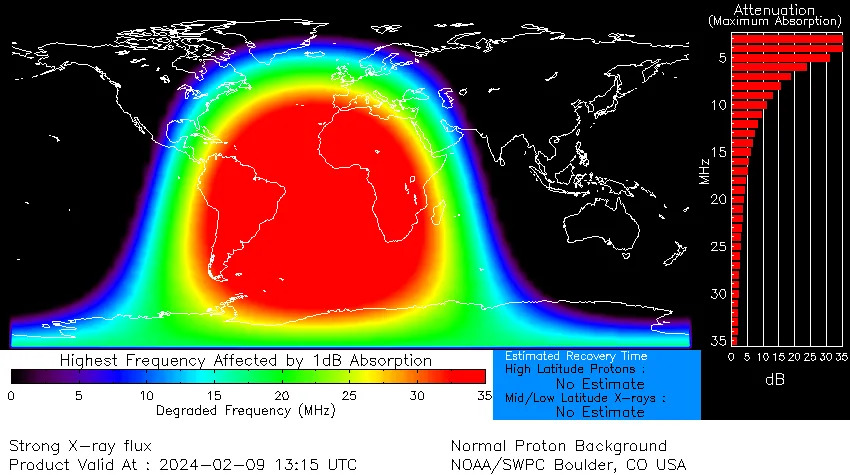
shortwave radio blackouts appear as a bright red region over South America, Southern Atlantic and Africa.
Solar flares are triggered when magnetic energy builds up in the solar atmosphere and is released in an intense burst of electromagnetic radiation. They are categorized by size into lettered groups, with X-class being the most powerful. Then there are M-class flares that are 10 times smaller than X-class flares, then C-class, B-class and finally A-class flares which are too weak to significantly affect Earth. Within each class, numbers from 1 to 10 (and beyond, for X-class flares) denote a flare's relative strength. The recent flare clocked in at X.3.38 according to Spaceweatherlive.com using data from NASA's GOES-16 satellite.
Related stories:
— Upcoming solar maximum may help solve the sun's gamma-ray puzzle
— Severe space weather is messing up bird migrations, new study suggests
— Solar storms can destroy satellites with ease — a space weather expert explains the science
The sun is becoming incredibly active as it approaches the most active part of its approximately 11-year solar cycle known as the "solar maximum." Just yesterday (Feb. 8) a giant sunspot crackling with M-class solar flares turned to face Earth. The sunspot — AR3576 — is so big it was seen by the Perseverance Rover on the surface of Mars. Could we see a similarly powerful X-flare eruption from the "Martian sunspot"? Only time will tell.
Solar and space weather scientists are monitoring the sun carefully as energetic solar flares and CMEs can be problematic for satellites in space and electronic technology here on Earth. Scientists at NOAA's Space Weather Prediction Center analyze sunspot regions daily to assess the threats. The World Data Center for the Sunspot Index and Long-term Solar Observations at the Royal Observatory of Belgium also tracks sunspots and records the highs and lows of the solar cycle to evaluate solar activity and improve space weather forecasting. NASA also has a fleet of spacecraft — known collectively as the Heliophysics Systems Observatory (HSO) — designed to study the sun and its influence on the solar system, including the effects of space weather.
'Martian' sunspot 15 times wider than Earth could soon bombard us with solar flares (photo & video)
Daisy Dobrijevic
Thu, February 8, 2024
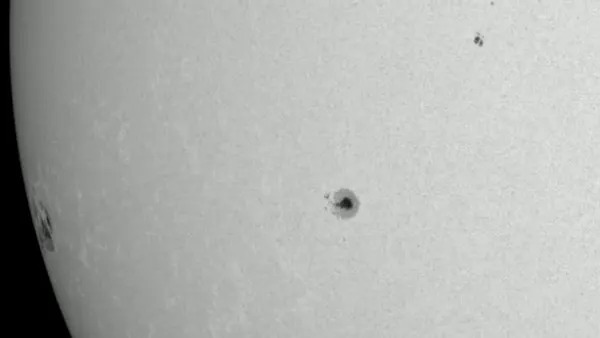
Gif animation showing the giant sunspot coming into view.
A sunspot so large it was seen from the surface of Mars is now facing Earth.
The gargantuan sunspot group AR3576 from end to end stretches for more than 124,274 miles (200,000 kilometers) and contains at least four dark cores each larger than Earth, according to Spaceweather.com. It was imaged by NASA's Perseverance Rover from the surface of Mars just last week.
The sunspot is so big it can be seen from Earth without the need for complex viewing equipment. Just don a pair of certified eclipse glasses and look up! For more information on how to safely view the sun check out our handy sun viewing guide.
Related: Powerful solar flare unleashes colossal plasma plume, sparks radio blackouts across South Pacific (video)
Sunspots are dark, cooler regions on the surface of the sun that can spawn eruptive disturbances such as solar flares and coronal mass ejections (CMEs) — large releases of plasma and magnetic field from the sun.
The frequency and intensity of sunspots visible on the surface can be used to indicate the level of solar activity at any given time during the 11-year solar cycle that is driven by the sun's magnetic field. As we approach solar maximum — the highest rate of activity — sunspot regions such as AR3576 are becoming more frequent.
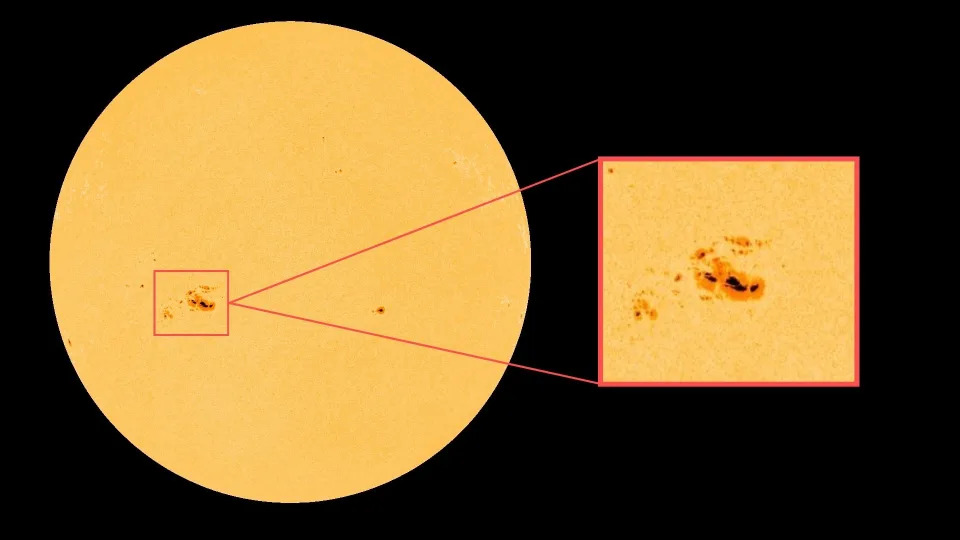
Sunspot AR3576 appears as a large dark orange spot on the surface of the sun.
The magnetically complex sunspot is already crackling with M-class solar flares, and National Oceanic and Atmospheric Administration (NOAA) forecasts predict this sunspot could pose a threat for X-class solar flares — the most powerful type of solar flare.
Solar flares are triggered when magnetic energy builds up in the solar atmosphere and is released in an intense burst of electromagnetic radiation. They are categorized by size into lettered groups, with X-class being the most powerful. Then there are M-class flares that are 10 times smaller than X-class flares, then C-class, B-class and finally A-class flares which are too weak to significantly affect Earth. Within each class, numbers from 1 to 10 (and beyond, for X-class flares) denote a flare's relative strength.
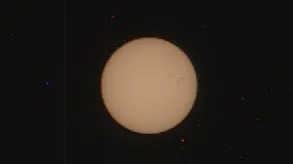
large dark patches on the surface of the sun when viewed from Mars.
Strong solar flares can also be accompanied by CMEs. When CMEs hit Earth they can disrupt our magnetosphere resulting in geomagnetic storms which in turn can create stunning aurora displays closer to equatorial regions than is usually possible during calm conditions.
Solar and space weather scientists are keeping a close eye on the sun as energetic solar flares and CMEs can be problematic for satellites in space and even electronic technology down on Earth.
Scientists at NOAA's Space Weather Prediction Center analyze sunspot regions daily to assess the threats. The World Data Center for the Sunspot Index and Long-term Solar Observations at the Royal Observatory of Belgium also tracks sunspots and records the highs and lows of the solar cycle to evaluate solar activity and improve space weather forecasting.
NASA also has a fleet of spacecraft — known collectively as the Heliophysics Systems Observatory (HSO) — designed to study the sun and its influence on the solar system, including the effects of space weather.
Did NASA Really Find Heaven? That Viral TikTok Claim ExplainedDaisy Dobrijevic
Fri, February 9, 2024
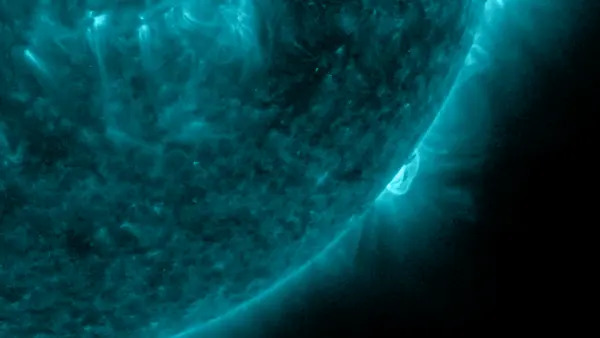
X-flare eruption on Feb 9.
The sun has unleashed a powerful X-class solar flare today, peaking at 8:10 a.m. (1310 GMT) and triggering shortwave radio blackouts across South America, Africa and the Southern Atlantic.
The solar flare erupted from sunspot AR3576 — the same sunspot that put on a fiery show on Feb. 5 with an M-class flare and plasma eruption.
Luckily for us, the sunspot moved beyond the sun's limb yesterday (Feb. 8), placing Earth outside of its direct firing line. "Goodness knows how big this flare would have been if it had happened this side of the sun," solar physicist Keith Strong wrote in a post on X.
Related: Solar maximum will arrive sooner and last longer than previously expected, say scientists
The monstrous solar flare was accompanied by a coronal mass ejection (CME) — a large release of plasma and magnetic field from the sun.
"There was a clear eruption with a coronal wave suggesting a very fast CME to the west, " said heliophysicist Alex Young in a post on X.
If a CME hits Earth it can cause disturbances to our magnetic field and lead to geomagnetic storms which can be troublesome for Earth-orbiting satellites but a delight to aurora chasers on the hunt for dramatic displays.
Due to the location of the sunspot so far south, it is unlikely that any CME from sunspot AR3576 will strike Earth directly; it is more likely to pass straight under us.
While we may not be in the direct firing line, it doesn't mean we are not affected. The X-flare caused extensive radio blackouts due to the strong pulse of X-rays and extreme ultraviolet radiation sent barrelling toward Earth at the time of the eruption. Traveling at the speed of light, the radiation reached Earth in just over eight minutes and ionized the upper layer of Earth's atmosphere — the thermosphere — triggering shortwave radio blackouts on the sun-lit portion of Earth at the time including South America, Africa and the Southern Atlantic.
Fri, February 9, 2024

X-flare eruption on Feb 9.
The sun has unleashed a powerful X-class solar flare today, peaking at 8:10 a.m. (1310 GMT) and triggering shortwave radio blackouts across South America, Africa and the Southern Atlantic.
The solar flare erupted from sunspot AR3576 — the same sunspot that put on a fiery show on Feb. 5 with an M-class flare and plasma eruption.
Luckily for us, the sunspot moved beyond the sun's limb yesterday (Feb. 8), placing Earth outside of its direct firing line. "Goodness knows how big this flare would have been if it had happened this side of the sun," solar physicist Keith Strong wrote in a post on X.
Related: Solar maximum will arrive sooner and last longer than previously expected, say scientists
The monstrous solar flare was accompanied by a coronal mass ejection (CME) — a large release of plasma and magnetic field from the sun.
"There was a clear eruption with a coronal wave suggesting a very fast CME to the west, " said heliophysicist Alex Young in a post on X.
If a CME hits Earth it can cause disturbances to our magnetic field and lead to geomagnetic storms which can be troublesome for Earth-orbiting satellites but a delight to aurora chasers on the hunt for dramatic displays.
Due to the location of the sunspot so far south, it is unlikely that any CME from sunspot AR3576 will strike Earth directly; it is more likely to pass straight under us.
While we may not be in the direct firing line, it doesn't mean we are not affected. The X-flare caused extensive radio blackouts due to the strong pulse of X-rays and extreme ultraviolet radiation sent barrelling toward Earth at the time of the eruption. Traveling at the speed of light, the radiation reached Earth in just over eight minutes and ionized the upper layer of Earth's atmosphere — the thermosphere — triggering shortwave radio blackouts on the sun-lit portion of Earth at the time including South America, Africa and the Southern Atlantic.

shortwave radio blackouts appear as a bright red region over South America, Southern Atlantic and Africa.
Solar flares are triggered when magnetic energy builds up in the solar atmosphere and is released in an intense burst of electromagnetic radiation. They are categorized by size into lettered groups, with X-class being the most powerful. Then there are M-class flares that are 10 times smaller than X-class flares, then C-class, B-class and finally A-class flares which are too weak to significantly affect Earth. Within each class, numbers from 1 to 10 (and beyond, for X-class flares) denote a flare's relative strength. The recent flare clocked in at X.3.38 according to Spaceweatherlive.com using data from NASA's GOES-16 satellite.
Related stories:
— Upcoming solar maximum may help solve the sun's gamma-ray puzzle
— Severe space weather is messing up bird migrations, new study suggests
— Solar storms can destroy satellites with ease — a space weather expert explains the science
The sun is becoming incredibly active as it approaches the most active part of its approximately 11-year solar cycle known as the "solar maximum." Just yesterday (Feb. 8) a giant sunspot crackling with M-class solar flares turned to face Earth. The sunspot — AR3576 — is so big it was seen by the Perseverance Rover on the surface of Mars. Could we see a similarly powerful X-flare eruption from the "Martian sunspot"? Only time will tell.
Solar and space weather scientists are monitoring the sun carefully as energetic solar flares and CMEs can be problematic for satellites in space and electronic technology here on Earth. Scientists at NOAA's Space Weather Prediction Center analyze sunspot regions daily to assess the threats. The World Data Center for the Sunspot Index and Long-term Solar Observations at the Royal Observatory of Belgium also tracks sunspots and records the highs and lows of the solar cycle to evaluate solar activity and improve space weather forecasting. NASA also has a fleet of spacecraft — known collectively as the Heliophysics Systems Observatory (HSO) — designed to study the sun and its influence on the solar system, including the effects of space weather.
'Martian' sunspot 15 times wider than Earth could soon bombard us with solar flares (photo & video)
Daisy Dobrijevic
Thu, February 8, 2024

Gif animation showing the giant sunspot coming into view.
A sunspot so large it was seen from the surface of Mars is now facing Earth.
The gargantuan sunspot group AR3576 from end to end stretches for more than 124,274 miles (200,000 kilometers) and contains at least four dark cores each larger than Earth, according to Spaceweather.com. It was imaged by NASA's Perseverance Rover from the surface of Mars just last week.
The sunspot is so big it can be seen from Earth without the need for complex viewing equipment. Just don a pair of certified eclipse glasses and look up! For more information on how to safely view the sun check out our handy sun viewing guide.
Related: Powerful solar flare unleashes colossal plasma plume, sparks radio blackouts across South Pacific (video)
Sunspots are dark, cooler regions on the surface of the sun that can spawn eruptive disturbances such as solar flares and coronal mass ejections (CMEs) — large releases of plasma and magnetic field from the sun.
The frequency and intensity of sunspots visible on the surface can be used to indicate the level of solar activity at any given time during the 11-year solar cycle that is driven by the sun's magnetic field. As we approach solar maximum — the highest rate of activity — sunspot regions such as AR3576 are becoming more frequent.

Sunspot AR3576 appears as a large dark orange spot on the surface of the sun.
The magnetically complex sunspot is already crackling with M-class solar flares, and National Oceanic and Atmospheric Administration (NOAA) forecasts predict this sunspot could pose a threat for X-class solar flares — the most powerful type of solar flare.
Solar flares are triggered when magnetic energy builds up in the solar atmosphere and is released in an intense burst of electromagnetic radiation. They are categorized by size into lettered groups, with X-class being the most powerful. Then there are M-class flares that are 10 times smaller than X-class flares, then C-class, B-class and finally A-class flares which are too weak to significantly affect Earth. Within each class, numbers from 1 to 10 (and beyond, for X-class flares) denote a flare's relative strength.

large dark patches on the surface of the sun when viewed from Mars.
Strong solar flares can also be accompanied by CMEs. When CMEs hit Earth they can disrupt our magnetosphere resulting in geomagnetic storms which in turn can create stunning aurora displays closer to equatorial regions than is usually possible during calm conditions.
Solar and space weather scientists are keeping a close eye on the sun as energetic solar flares and CMEs can be problematic for satellites in space and even electronic technology down on Earth.
Scientists at NOAA's Space Weather Prediction Center analyze sunspot regions daily to assess the threats. The World Data Center for the Sunspot Index and Long-term Solar Observations at the Royal Observatory of Belgium also tracks sunspots and records the highs and lows of the solar cycle to evaluate solar activity and improve space weather forecasting.
NASA also has a fleet of spacecraft — known collectively as the Heliophysics Systems Observatory (HSO) — designed to study the sun and its influence on the solar system, including the effects of space weather.
Cassidy Ward
Fri, February 9, 2024
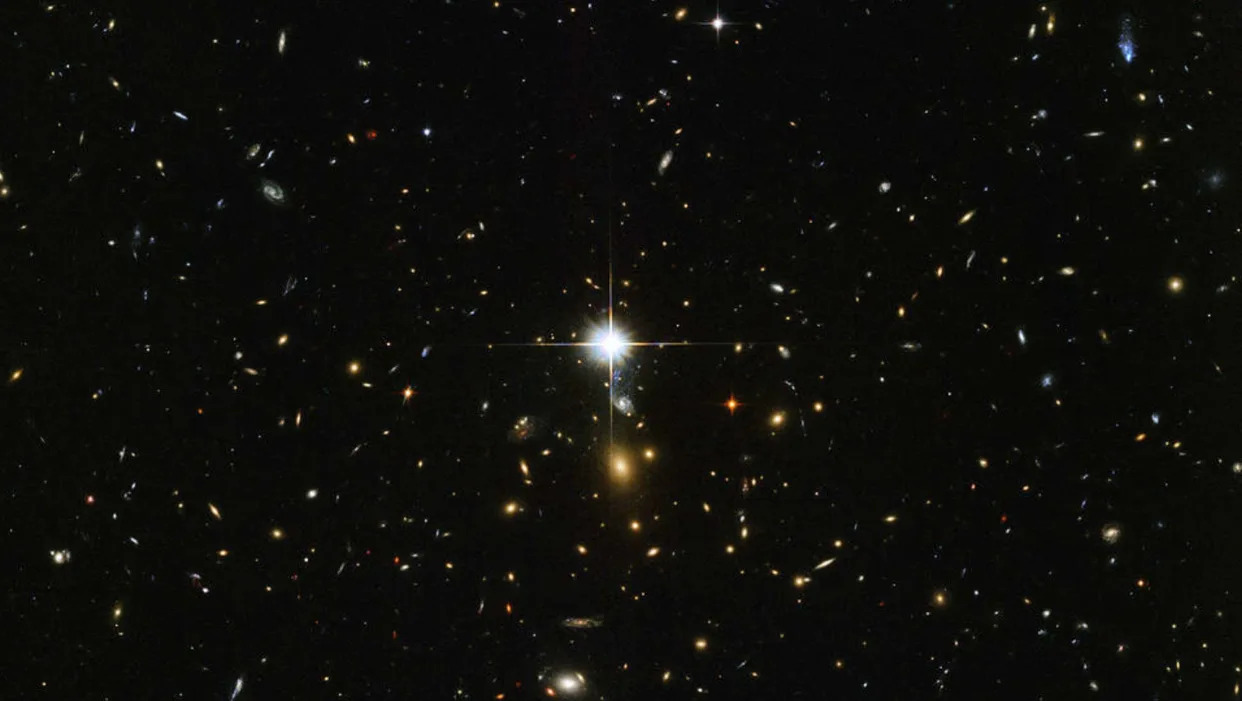
Did NASA Really Find Heaven? That Viral TikTok Claim Explained
When it comes to outer space, we’ve learned to expect the unexpected. Every time we think we have a handle on what’s out there and how it all works, we build a new telescope or figure out some new technique and reality gets a little bit weirder.
In 1994, an alleged Hubble image was published alongside a report that NASA scientists had discovered the “City of God” in deep space. If you’re feeling skeptical, that’s good and correct. We like to imagine brave explorers like the crew of The Ark, nobly seeking out new worlds in deep space, despite the danger. When compared with other occupations, leaving the planet has a higher-than-average likelihood of ending in death, but if an astronaut is headed for the afterlife they don’t expect to fly there direct. Or do they?
A viral video making the rounds on TikTok has resurrected the 30-year-old image of God’s heavenly hangout. Just to be clear right up front, the image is fake, but let’s get into how we know that it’s fake and not part of an elaborate government cover up.
The First Time Hubble “Saw Heaven”
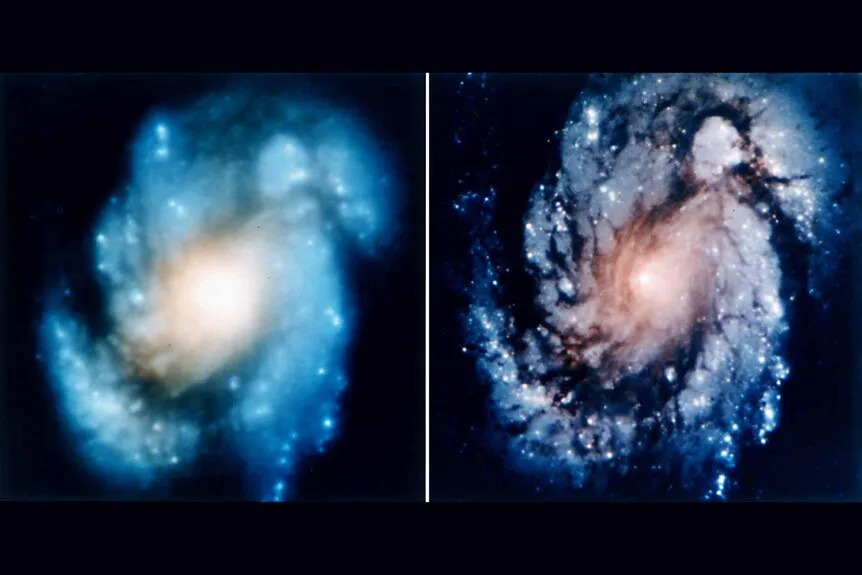
Galaxy M100 before and after Hubble repair
This before (left) and after (right) image of the core of the galaxy M100 shows the dramatic improvement in Hubble's view of the universe after the first servicing mission in December 1993. Photo: NASA
The modern popular image of the cosmos was largely defined by the Hubble Space Telescope and its awe-inspiring views of the universe. Hubble launched aboard the space shuttle Discovery on April 24, 1990 and was deployed the following day. Pretty quickly, NASA realized that there was a defect in the primary mirror, causing the images to come in blurry. Despite that, Hubble started sending back images of nearby planets and distant cosmic objects, and astronomers got busy rewriting our understanding of existence.
In December 1993, astronauts carried out the first Hubble servicing mission. They installed instruments and updates designed to correct for the flawed mirror. After installation, the clarity of Hubble images was dramatically improved. At the time, Hubble was the most powerful orbital telescope in existence, and it allowed us to investigate the nature of the universe like never before. Humanity was being granted an unprecedented view of the heavens and we were primed for world-shattering discoveries.
RELATED: Hubble spies what may be a rogue black hole just 5,000 light years away
The TikTok in question claims that NASA actually found heaven with the Hubble Space Telescope back in 1994, shortly after repairs were completed. All of the video’s claims come in the form of a voiceover, which itself is based on information the narrator allegedly received from their uncle, who allegedly worked for NASA. Already, we have to make a lot of concessions to believe what we’re being told. It’s not passing the sniff test, but let’s keep going.
Over the course of nearly five minutes, we're told that this image of a heavenly building is a confirmed NASA leak and that the organization attempted to bury the truth about it. None of that is true, of course, even if the video’s narrator really does have an uncle who works at NASA.
People have been claiming that NASA found evidence of some religious tradition or another for decades. As soon as scientists really started digging into the clockwork of the universe, people started claiming to find evidence of the divine.
No, NASA Didn’t Take Pictures of Heaven with the Hubble Space Telescope (or Any Other Telescope)
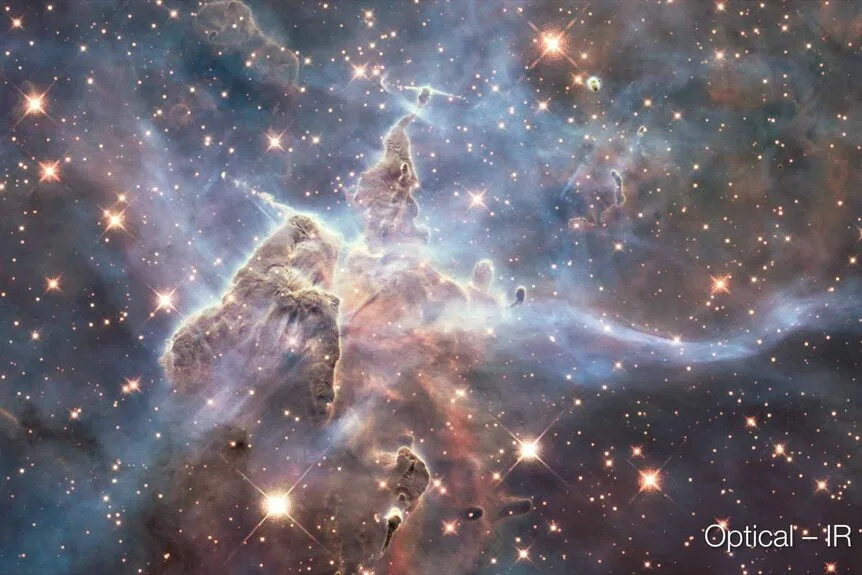
Herbig Haro 901 is an immense pillar of gas and dust inside the Carina Nebula, a huge star-forming region in our galaxy. The pillar is several light-years tall and contains a few massive young stars.
NASA, ESA,and the Hubble 20th Anniversary Team (STScI)
In 2016, an image started circulating online reported to feature the gates of heaven nestled into a nebula. Captions featured the usual claims that scientists were stymied by what they had found, but that wasn’t true, because the image was fake. More accurately, it was a work of art that was later co-opted to sell a religious story online. The image was one of a number of similar works by Adam Ferriss, an artist known to use a pixel sorting process to create art out of Hubble images. Ferriss began with an actual Hubble image of Messier 17, the Swan Nebula, and created the so-called gates of heaven by sorting the pixels to create stacks. Ferriss never made any claims of legitimacy about his work, but it was later picked up by third parties who attached the heaven’s gate narrative.
At least those posters had the good sense to pick up a new image and spin a new story. The recent viral video on the City of God image couldn’t even do that. Instead, it recycles a story from 1994, one that everyone knew was fake when it hit newsstands 30 years ago. The image was originally published in a Weekly World News story called “Heaven Photographed by Hubble Telescope.” The story was republished online in 2009. For those of you who don’t remember Weekly World News, it was a supermarket tabloid concerned with half-bat, half-human hybrids and figuring out whether you were descended from aliens. You bought Weekly World News for the chuckles, not because it was telling you the truth they didn’t want you to know.
The story is built on a tenuous foundation of truth. It begins talking about Hubble’s recent repairs, the ones which corrected the mirror defect, and the first clear images taken afterward. Allegedly, astronomers pointed Hubble at “the edge of the universe” and saw a brilliant celestial city floating in space. The image, like the magazine itself, is in black and white. It shows what looks like a distant city, or maybe a large house on a hill, set against a dark, star-speckled sky.
Spikes of light sprawl from the edges of the city, stretching out into space at odd angles. It helps to sell the image, giving the city a heavenly look, but it also reveals its artificial nature. Because the spikes are all wrong. You’ve probably noticed, when looking at images from Hubble or the James Webb Space Telescope (JWST) that bright objects like stars have characteristic spires of light spread out around them. You might also have noticed that the spikes visible in Hubble images are different from the spikes in JWST images, and there’s a reason for that.
RELATED: Psst! Wanna see an actual Hubble image of a planet forming around a nearby star?
Diffraction spikes are a key feature of images taken with mirror-based telescopes. Light collected by the primary mirror gets distorted a little bit, both from interacting with the mirror itself and from passing by the support struts. When looking at large, diffuse objects the distortion is small enough that it’s not really noticeable. When looking at stars, however, the high concentration of bright light causes distinct spikes. Importantly, diffraction spikes are artifacts of the telescope’s structure, they are not representative of the object being observed, which means we can determine whether a particular image was taken by a particular telescope from the pattern of spikes.
Right off the bat, the scattered nature of the spikes in the picture of heaven doesn’t make sense. There are roughly a dozen spikes splayed out in all directions but favoring the left side. The diffraction spike pattern doesn’t match Hubble or any other orbital telescope. Hubble’s diffraction spikes (which you can see in the actual Hubble image, above) come in the form of a simple cross, paired horizontal and vertical spikes. There are only four and they always splay out at 90-degree angles to one another. That doesn’t prove the story or that the image is fake, but it does prove Hubble didn’t capture it.
The rest of the story falls apart if you pull its threads even a little. It hinges on the comments of author and researcher Dr. Marcia Masson. The thing is, there is no record of Dr. Masson in the scientific literature, doing astronomical work at the time of the alleged photo’s release or at any other time.
Every other claim in the story including that then-President and Vice President Bill Clinton and Al Gore had “taken a deep personal interest” in the photo and that scientists were forced to conclude that “the only logical explanation was that the city was inhabited by the souls of the dead” and “we found where God lives,” come from unnamed NASA sources.
Of course, maybe that’s all just a part of the cover up.
The story of The Ark is currently in stasis but returns for Season 2 on SYFY later this year! Who knows what they'll find. In the meantime, catch a wide selection of science fiction streaming now on Peacock.
Massive European Satellite to Plummet Back Down to Earth Uncontrollably
Victor Tangermann
Thu, February 8, 2024
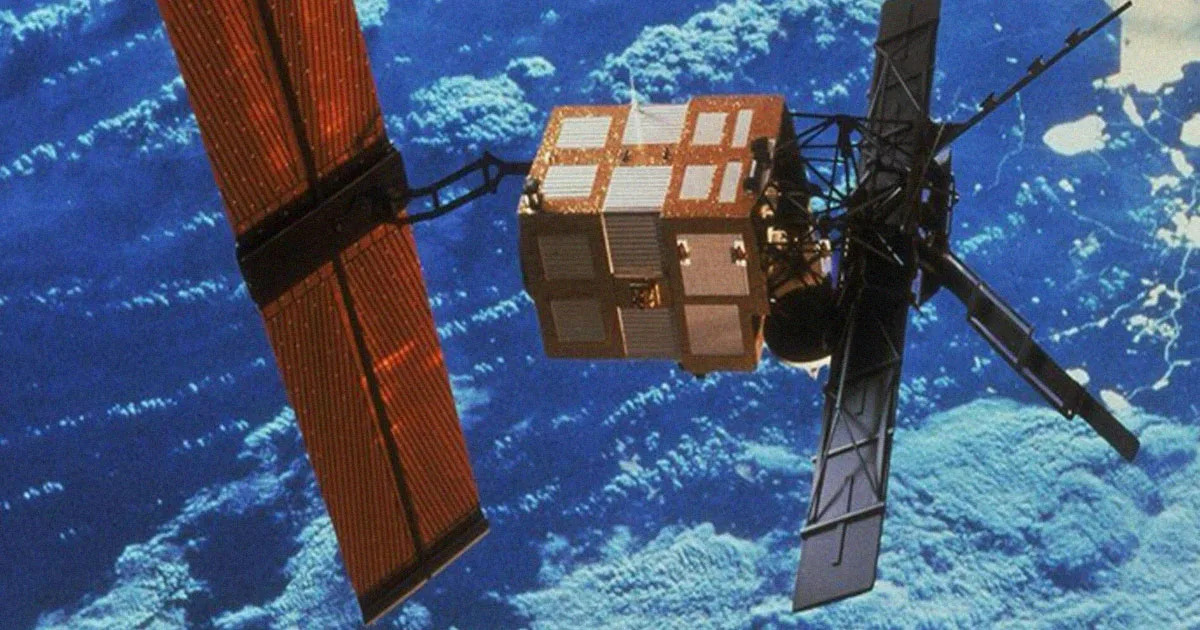
Tin Can Deorbit
A massive, defunct satellite is set to come crashing through the Earth's atmosphere, plummeting towards the ground, in just a matter of weeks.
Launched into orbit in 1995, the European Space Agency's European Remote Sensing 2 (ERS-2) satellite was decommissioned over a decade ago. Since then, it's used up the last of its fuel reserves and is set to reenter the atmosphere "around mid-February" per an ESA statement.
Even without the fuel, the massive Earth observatory still weighs north of 5,000 pounds, a giant piece of space debris that could technically wreak havoc if it were to crash into a populated area.
Fortunately, as the ESA is quick to point out in a FAQ specifically about the reentry, "the annual risk of an individual human being injured by space debris is under 1 in 100 billion."
In other words, you're orders of magnitude more likely to be hit by lightning.
Crashing Down
As Space.com points out, far larger objects have uncontrollably made their descent from orbit, including the core stage of China's Long March 5B rocket, which weighed a whopping 23 tons when it crashed back down a week after liftoff back in 2022.
NASA officials have since called out China for its reckless habit of allowing massive rocket parts to come raining down unassisted.
And the risks are real, especially when it comes to recently-launched rocket boosters. Just last month, videos circulated on social media showing what appears to be a pair of rocket boosters of a Chinese Long March 3B rocket uncontrollably tumbling towards an inhabited area, resulting in massive fireballs.
As to where the ESA's mammoth satellite will land is impossible to tell at this point.
"The satellite is under frequent observation, and we are tracking its orbital altitude as it decays," the ESA's FAQ reads. "However, because the reentry is ‘natural’, it is impossible to predict exactly when and where the satellite will begin to burn up."
Besides turning into a massive piece of space junk, the ERS-2 satellite has "collected a bounty of data on Earth’s diminishing polar ice, changing land surfaces, sea-level rise, warming oceans and atmospheric chemistry," per the agency. It has also assisted during natural disasters.
While a largely uncontrolled descent sounds like a reckless decision, its eventual plummet is still technically a more desirable outcome than having it pose a threat to space explorers later down the line.
Our planet's orbit is already chockful of space junk — and the problem is only bound to get worse as more rockets are launched (and satellites decommissioned).
More on reentries: NASA Terrified of Space Station Careening Out of Control and Crashing Into People
Victor Tangermann
Thu, February 8, 2024

Tin Can Deorbit
A massive, defunct satellite is set to come crashing through the Earth's atmosphere, plummeting towards the ground, in just a matter of weeks.
Launched into orbit in 1995, the European Space Agency's European Remote Sensing 2 (ERS-2) satellite was decommissioned over a decade ago. Since then, it's used up the last of its fuel reserves and is set to reenter the atmosphere "around mid-February" per an ESA statement.
Even without the fuel, the massive Earth observatory still weighs north of 5,000 pounds, a giant piece of space debris that could technically wreak havoc if it were to crash into a populated area.
Fortunately, as the ESA is quick to point out in a FAQ specifically about the reentry, "the annual risk of an individual human being injured by space debris is under 1 in 100 billion."
In other words, you're orders of magnitude more likely to be hit by lightning.
Crashing Down
As Space.com points out, far larger objects have uncontrollably made their descent from orbit, including the core stage of China's Long March 5B rocket, which weighed a whopping 23 tons when it crashed back down a week after liftoff back in 2022.
NASA officials have since called out China for its reckless habit of allowing massive rocket parts to come raining down unassisted.
And the risks are real, especially when it comes to recently-launched rocket boosters. Just last month, videos circulated on social media showing what appears to be a pair of rocket boosters of a Chinese Long March 3B rocket uncontrollably tumbling towards an inhabited area, resulting in massive fireballs.
As to where the ESA's mammoth satellite will land is impossible to tell at this point.
"The satellite is under frequent observation, and we are tracking its orbital altitude as it decays," the ESA's FAQ reads. "However, because the reentry is ‘natural’, it is impossible to predict exactly when and where the satellite will begin to burn up."
Besides turning into a massive piece of space junk, the ERS-2 satellite has "collected a bounty of data on Earth’s diminishing polar ice, changing land surfaces, sea-level rise, warming oceans and atmospheric chemistry," per the agency. It has also assisted during natural disasters.
While a largely uncontrolled descent sounds like a reckless decision, its eventual plummet is still technically a more desirable outcome than having it pose a threat to space explorers later down the line.
Our planet's orbit is already chockful of space junk — and the problem is only bound to get worse as more rockets are launched (and satellites decommissioned).
More on reentries: NASA Terrified of Space Station Careening Out of Control and Crashing Into People

No comments:
Post a Comment